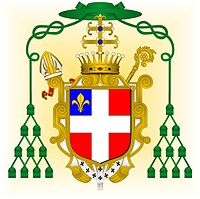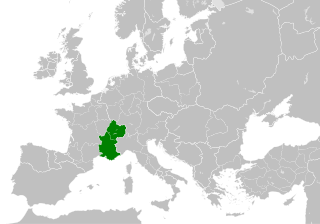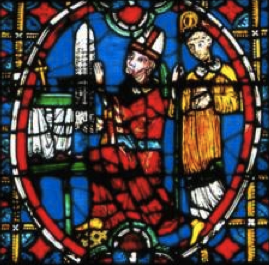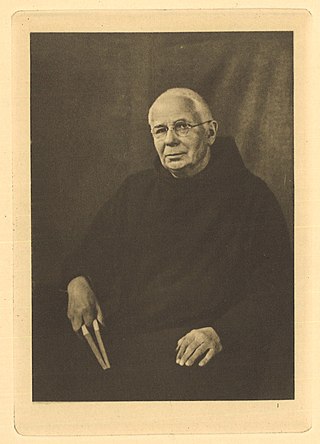
Peter of Savoy (French : Pierre de Savoie; died November 1332) was a member of the House of Savoy and a prelate of the 14th century.

Peter of Savoy (French : Pierre de Savoie; died November 1332) was a member of the House of Savoy and a prelate of the 14th century.
Peter was the son of Count Thomas III of Piedmont and his wife Guia de Bourgogne. [1] His date of birth is unknown. He is mentioned along with his brothers in his father's will dated 14 May 1282 ("Philippum de Sabaudia filium meum primogenitum [...] aliis filiis meis Petro, Thomæ, Amedeo et Guillermo fratribus suis"), as well as in a charter of 24 May 1286 ("Philippi Petri Thome Amedei et Guillelmi"). In 1304, he was dean of Salisbury Cathedral and a canon at Lyon.
In December 1307, Peter was appointed Archbishop of Lyon and Primate of Gaul. [2] Unlike his predecessor, Louis de Villars, Peter did not accept the gradual takeover of Lyon by the kingdom of France. He therefore encouraged the residents to revolt, [3] and encouraged them to strengthen the city walls, and he put aside the historical dispute between the archbishop and the cathedral chapter, [4] and challenged the presence of the "gardiateur" (overseer) imposed by the king of France, Philip the Fair, thus providing a pretext for Philip to send his son Louis, King of Navarre, and his brother Charles of Valois with an army to besiege Lyon in 1310.
The war ended with the intervention of the Peter's uncle, Amadeus V, Count of Savoy, who reluctantly sided with the French king to avoid becoming the king's next victim. [5] A treaty was signed on 10 April 1312, by which the archbishop lost control of the administration of justice in Lyon to the king, and was obliged to agree to the incorporation of Lyon into the kingdom of France. A definitive treaty of 4 April 1320 with the new king, Philip V, restored the jurisdiction of the city to the archbishop, but under royal sovereignty. The people of Lyon received several franchises, such as the right to set taxes for the benefit of the city.
However, the king refused the archbishop's demands for compensation for the depredations of the royal troops during the siege, both for their mistreatment of the inhabitants and particularly of the clergy. These were the subject of two written memoranda, one composed by the clerics of Lyon between the opening of the Council of Vienne on 16 October 1311 and the treaty of 10 April 1312, called Gravamina or Grauamina, the other by the prosecutor of the bailiff of Mâcon, between this treaty and the end of 1312, called Avisamenta. [6] The first sought to demonstrate the enormity of the royal depredations, setting the cost of them at 150,000 livres tournois ; the second, on the contrary, minimized them, putting the cost at only 10,000 livres tournois. Of this, the royal treasury only paid 2,000 livres, to which the king added, by "royal munificence" (Latin : sua munificentia regalis) 500 more. [7] These compensations, such as they were, were paid to the archbishop on 27 December 1312.
Also during his term of office Chazeaux Abbey was founded for a community of Poor Clares at Firminy. In 1316, the archbishop saw the election and coronation of Pope John XXII in Lyon.
Peter had an illegitimate son by an unknown mother:

Humbert I, better known as Humbert the White-Handed or Humbert Whitehand, was the founder of the House of Savoy. Of obscure origins, his service to the Holy Roman Emperors Henry II and Conrad II was rewarded with the counties of Maurienne and Aosta and lands in Valais, all at the expense of local bishops and archbishops; the territory came to be known as the county of Savoy.

Robert II of Burgundy was Duke of Burgundy between 1272 and 1306 as well as titular King of Thessalonica. Robert was the third son of duke Hugh IV and Yolande of Dreux.

The Kingdom of Burgundy, known from the 12th century as the Kingdom of Arles, also referred to in various context as Arelat, the Kingdom of Arles and Vienne, or Kingdom of Burgundy-Provence, was a realm established in 933 by the merger of the kingdoms of Upper and Lower Burgundy under King Rudolf II. It was incorporated into the Holy Roman Empire in 1033 and from then on was one of the empire's three constituent realms, together with the Kingdom of Germany and the Kingdom of Italy. By the mid-13th century at the latest, however, it had lost its concrete political relevance.
Henri-Jean Martin was a leading authority on the history of the book in Europe, and an expert on the history of writing and printing. He was a leader in efforts to promote libraries in France, and the history of libraries and printing.

Agnes of France was Duchess of Burgundy by marriage to Robert II, Duke of Burgundy. She served as regent of Burgundy during the minority of her son's reign in 1306–1311.

Rodulf was the archbishop of Bourges from 840 until his death. He is remembered as a skillful diplomat and a proponent of ecclesiastical reform. As a saint, his feast has been celebrated on 21 June.

The Archdiocese of Tarentaise was a Roman Catholic diocese and archdiocese in France, with its see in Moûtiers, in the Tarentaise Valley in Savoie. It was established as a diocese in the 5th century, elevated to archdiocese in 794, and disbanded in 1801. The diocese of Tarentaise was again formed in 1825, and united with the diocese of Chambéry and diocese of Saint-Jean-de-Maurienne to form the Archdiocese of Chambéry, Maurienne and Tarentaise in 1966.
Louis of Savoy, Count of Geneva from 1460, became King of Cyprus in 1459 upon his second marriage to Charlotte of Cyprus, reigning together with and in the right of his wife until 1464. He was the second son and namesake of Louis, Duke of Savoy and his wife, Anne of Lusignan, daughter of King Janus of Cyprus.
Jean Barthélémy Richard was a French historian, who specialized in medieval history. He was an authority on the Crusades, and his work on the Latin missions in Asia has been qualified as "unsurpassed". Richard was a member of the Institut de France. He was President of the prestigious Académie des Inscriptions et Belles-Lettres in 2002. He was born in Le Kremlin-Bicêtre, France in February 1921. Richard died in January 2021, two weeks shy of his 100th birthday.

The Roman Catholic Archdiocese of Chambéry, Saint-Jean-de-Maurienne, and Tarentaise is an archdiocese of the Latin Church of the Roman Catholic Church in France and a suffragan of the Archdiocese of Lyon. The archepiscopal see is Chambéry Cathedral, located in the city of Chambéry. The archdiocese encompasses the department of Savoie, in the Region of Rhône-Alpes.

Mouxy is a commune in the Savoie department in the Auvergne-Rhône-Alpes region in south-eastern France.

Jean Lemoine, Jean Le Moine, Johannes Monachus was a French canon lawyer, Cardinal, bishop of Arras and papal legate. He served Boniface VIII as representative to Philip IV of France, and founded the Collège du Cardinal Lemoine, in Paris. He is the first canon lawyer to formulate the legal principle of the presumption of innocence.
Geneviève Hasenohr is a French philologist and prolific scholar of medieval and Renaissance French literature. She has authored or contributed to more than forty books, written at least fifty academic articles and reviews, and prepared numerous scholarly editions.
Guichard, also known under the name of Guichard of Pontigny was a French churchman, Archbishop of Lyon from 1165.

Renaud de Forez was a French churchman who was Archbishop of Lyon as Renaud II (1193–1226). A son of Count Guigues II of Forez, Renaud acted as regent of the county of Forez for his nephew, Guigues IV, between 1203 and 1218. He joined the Lyon chapter during the episcopate of Guichard of Pontigny. He became abbot of Saint-Just in 1182.

Bruno Galland is a French medievalist and archivist.

Ursmer Berlière, born Alfred Berlière (1861–1932) was a monk of Maredsous Abbey and a monastic historian whose bibliography ran to 360 publications.

Émile Picot was a French Romance philologist.
Ermengarde was a medieval noblewoman. Through her first marriage, to Rotbold II, Count of Provence, she was countess of Provence, and from 1011 to 1032 Ermengarde was the last queen of independent Burgundy by virtue of her second marriage to Rudolf III of Burgundy.

Charles de Grandmaison was a French archivist and historian.